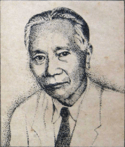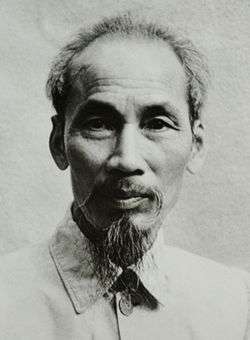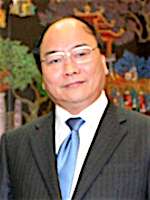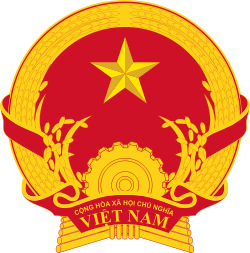List of Prime Ministers of Vietnam
The Prime Minister of the Socialist Republic of Vietnam (Vietnamese: Thủ tướng Chính phủ nước Cộng hòa xã hội chủ nghĩa Việt Nam), known as Chairman of the Council of Ministers (Vietnamese: Chủ tịch Hội đồng Bộ trưởng) from 1981 to 1992, is the highest office within the Central Government. The prime minister is simultaneously the Secretary of the Government Caucus Commission, a Party organ on government affairs, and Deputy Chairman of the Council for Defence and Security, a organ of the National Assembly.[1] Throughout its history, the office has been responsible, at least in theory but not always in practice, for handling Vietnam's internal policies. Since Vietnam is a one-party state, with the Communist Party of Vietnam being the sole party allowed by the constitution, all the prime ministers of the Democratic Republic and the Socialist Republic have been members of the party while holding office. The current prime minister is Nguyễn Xuân Phúc, since 7 April 2016. He is sixth-ranked in the Political Bureau (Politburo).[2][note 1]
The Office of the Prime Minister of the Socialist Republic traces its lineage back to Hồ Chí Minh, the first Prime Minister of the Democratic Republic. The office has no official connection, or lineage, to the heads of government of the former South Vietnam (with the exception of Huỳnh Tấn Phát, a communist and the last head of government of South Vietnam). Officially there have been 7 prime ministers of Vietnam,[3] but there have been 29 prime ministers of Vietnam if the prime ministers of the Empire of Vietnam and South Vietnam are counted.[4]
The Prime Minister is elected by the proposal of the President of Vietnam to the National Assembly and is responsible to the National Assembly, which elects all ministers to government. Activity reports by the Prime Minister must be given to the National Assembly, while the Standing Committee of the National Assembly supervises the activities of the Central Government and the Prime Minister. Finally, the deputies of the National Assembly have the right to question the Prime Minister and other members of government.[5]
Cabinet Secretary of the Empire of Vietnam (1945)
| № [note 2] |
Name (Birth–Death) |
Took office | Left office | Emperor (Birth–Death) |
Portrait | |
|---|---|---|---|---|---|---|
| 1 | 1 | Trần Trọng Kim (1883–1953) |
17 April 1945 | 23 August 1945 | Bảo Đại (1913–1997) |
 |
Prime Ministers of the Democratic Republic of Vietnam (1945–1976)
| № [note 2] |
Name (Birth–Death) |
Took office | Left office | Rank [note 3] |
National Assembly | Portrait | |
|---|---|---|---|---|---|---|---|
| 1 | 1 | Hồ Chí Minh (1890–1969) |
2 September 1945 | 20 September 1955 | 1 | 1st convocation (1946–1960) |
 |
| 2 | 2 | Phạm Văn Đồng (1906–2000) |
20 September 1955 | 2 July 1976 | 6 | 1st convocation (1946–1960) |
 |
| 5 [note 4] |
2nd convocation (1960–1964) | ||||||
| 3rd convocation (1964–1971) | |||||||
| 4 | 4th convocation (1971–1975) | ||||||
| 5th convocation (1975–1976) | |||||||
Chairman of the Provisional Revolutionary Government of the Republic of South Vietnam (1969–1976)
| № [note 2] |
Name (Birth–Death) |
Took office | Left office | President (Birth–Death) |
Portrait | |
|---|---|---|---|---|---|---|
| 1 | 1 | Huỳnh Tấn Phát (1913–1989) |
8 June 1969 | 2 July 1976 | Nguyễn Hữu Thọ (1910–1996) |
— |
Heads of government of the Socialist Republic of Vietnam (1976–present)
Prime Ministers (1976–1981)
| № [note 2] |
Name (Birth–Death) |
Took office | Left office | Rank [note 3] |
National Assembly | Portrait | |
|---|---|---|---|---|---|---|---|
| 2 | 1 | Phạm Văn Đồng (1906–2000) |
2 July 1976 | 4 July 1981 | 3 | 6th convocation (1976–1981) |
 |
Chairmen of the Council of Ministers (1981–1992)
| № [note 2] |
Name (Birth–Death) |
Took office | Left office | Rank [note 3] |
National Assembly | Portrait | |
|---|---|---|---|---|---|---|---|
| 2 | 1 | Phạm Văn Đồng (1906–2000) |
4 July 1981 | 18 June 1987 | 3 | 7th convocation (1981–1987) |
 |
| 2 [note 5] | |||||||
| — | |||||||
| 3 | 2 | Phạm Hùng (1912–1988) |
18 June 1987 | 10 March 1988 [note 6] |
2 | 8th convocation (1987–1992) |
— |
| — |
— |
Võ Văn Kiệt (1922–2008) |
10 March 1988 | 22 June 1988 | 5 | 8th convocation (1987–1992) |
— |
| 4 | 3 | Đỗ Mười (1917–) |
22 June 1988 | 8 August 1991 | 3 | 8th convocation (1987–1992) |
 |
| 5 | 4 | Võ Văn Kiệt (1922–2008) |
8 August 1991 | 24 September 1992 | 3 | 8th convocation (1987–1992) |
— |
Prime Ministers (1992–present)
| № [note 2] |
Name (Birth–Death) |
Took office | Left office | Rank [note 3] |
National Assembly | Portrait | |
|---|---|---|---|---|---|---|---|
| 5 | 4 | Võ Văn Kiệt (1922–2008) |
24 September 1992 | 24 September 1997 | 3 | 9th convocation (1992–1997) |
— |
| 6 | 5 | Phan Văn Khải (1933–) |
24 September 1997 | 27 June 2006 | 3 | 10th convocation (1997–2002) |
 |
| 11th convocation (2002–2007) | |||||||
| 7 | 6 | Nguyễn Tấn Dũng (1949–) |
27 June 2006 | 6 April 2016 | 3 | 11th convocation (2002–2007) |
.jpg) |
| 12th convocation (2007–2011) | |||||||
| 13th convocation (2011–2016) | |||||||
| 8 | 7 | Nguyễn Xuân Phúc (1954–) |
7 April 2016 | Incumbent | 6 | 13th convocation (2011–2016) |
 |
| 14th convocation (2016–2021) | |||||||
See also
Notes
- 1.^ The Politburo of the Central Committee is the highest decision-making body of the CPV and the Central Government. The membership composition, and the order of rank of the individual Politburo members is decided in an election within the newly formed Central Committee in the aftermath of a Party Congress.[6] The Central Committee can overrule the Politburo, but that does not happen often.[7]
- 2.^ These numbers are official. The "—" denotes acting head of government. The first column shows how many heads of government there have been in Vietnamese history, while the second show how many heads of government there was in that state.
- 3.^ The Central Committee when it convenes for its first session after being elected by a National Party Congress elects the Politburo.[6] According to David Koh, in interviews with several high-standing Vietnamese officials, the Politburo ranking is based upon the number of approval votes by the Central Committee. Lê Hồng Anh, the Minister of Public Security, was ranked 2nd in the 10th Politburo because he received the second-highest number of approval votes. Another example being Tô Huy Rứa of the 10th Politburo, he was ranked lowest because he received the lowest approval vote of the 10th Central Committee when he standing for election for a seat in the Politburo. This system was implemented at the 1st plenum of the 10th Central Committee.[8] The Politburo ranking functioned as an official order of precedence before the 10th Party Congress, and some believe it still does.[6]
- 4.^ Phạm Văn Đồng became 4th-ranked member in the Politburo hierarchy when Hồ Chí Minh, the 1st ranked, died in 1969.[9]
- 5.^ Phạm Văn Đồng was ranked 2nd in the Politburo hierarchy when Lê Duẩn, the General Secretary of the Central Committee, died on 10 July 1986.
- 6.^ Died in office.
References
General
The prime ministers, and when they took and left office, was taken from these sources:
- "Trần Trọng Kim" (PDF) (in Vietnamese). giaocam.saigonline.com. Retrieved 15 September 2012.
- "Cac Thu Tuong Chinh Phu Tien Nhiem" [Predecessors of the current Prime Minister] (in Vietnamese). Government of Vietnam. Retrieved 15 September 2012.
Specific
- ↑ "Quyet đinh cua Ban Bi thư so 48-QĐ/TW: Ve viec lap Ban Can su đang o cac bo va co quan ngang bo, ngay 14 thang 12 nam 1992" [The decision of the Secretariat of 48-QD/TW: Commission for Elaboration of the party in government ministries and ministerial-level agencies, December 14, 1992] (in Vietnamese). Communist Party of Vietnam. 20 June 2012. Retrieved 8 May 2012.
- ↑ "Party Congress announces CPVCC Politburo members". Government of the Socialist Republic of Vietnam. 19 January 2011. Retrieved 20 June 2012.
- ↑ "Cac Thu Tuong Chinh Phu Tien Nhiem" [The Predecessors of the Prime Minister] (in Vietnamese). Office of the Prime Minister. thutuong-chinhphu.vn. Retrieved 20 June 2012.
- ↑ "Vietnam". worldstatesmen.org. Retrieved 14 October 2012.
- ↑ "Political system". Government of the Socialist Republic of Vietnam. Retrieved 20 April 2012.
- 1 2 3 Van & Cooper 1983, p. 69.
- ↑ Abuza, Zachary (16 November 2001). "The Lessons of Le Kha Phieu: Changing Rules in Vietnamese politics". Vietnamese Professionals of America. The Catholic University of America. p. 12.
- ↑ Koh 2008, p. 666.
- ↑ Woods 2002, p. 74.
Bibliography
- Koh, David (July–August 2008). "Leadership Changes at the 10th Congress of the Vietnamese Communist Party". Asian Survey. University of California Press. 48 (4): 650–672. doi:10.1525/as.2008.48.4.650.
- Van, Canh Nguyen; Cooper, Earle (1983). Vietnam under Communism, 1975–1982. Hoover Press. ISBN 9780817978518.
- Woods, L. Shelton (2002). Vietnam: a Global Studies Handbook. ABC-CLIO. ISBN 9781576074169.
